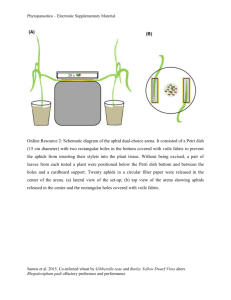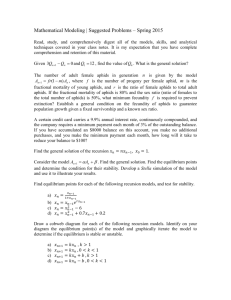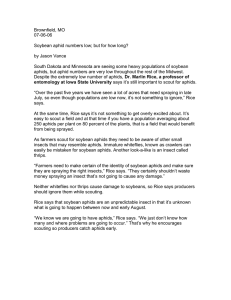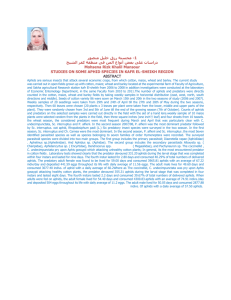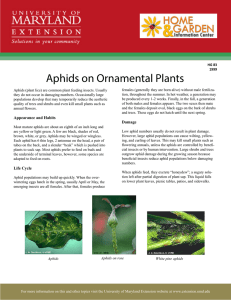Comparison of the Cytochrome Oxidase subunit I Gene in Soldier and Non-soldier Aphids
advertisement
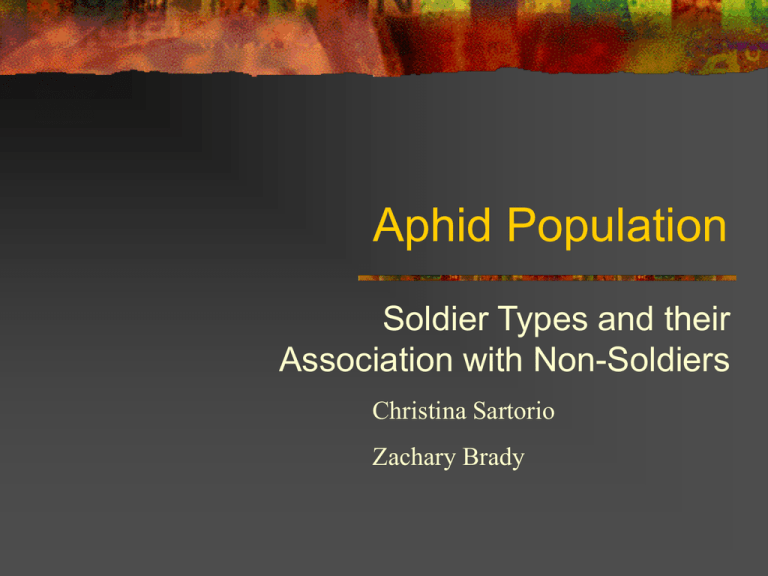
Aphid Population Soldier Types and their Association with Non-Soldiers Christina Sartorio Zachary Brady Fossil History Aphids are related to Adelgids and Phylloxerids who evolved about 280 million years ago The oldest known fossil is Triassoaphis cubitus from the Triassic about 220 million years ago Species of Aphids There are about 4000 species of aphids in the world of which about 250 are serious pests. Scientists believe that the number of species remained relatively small until the angiosperms (flowering plants) became more common, then as the aphids adapted to these new and rapidly varying plants their species numbers also increased. Aphid Range and Appearance Twenty-five percent of all plant species are infested with aphids, and though it is believed the species of aphids has followed that of plants, not all groups of plants are equally infected with these parasites. Aphids are part of the Superfamily Aphidoidae and are described as small (1-10 mm) soft bodied insects with, or more commonly without, wings. Species Variation The Compositae, the 3rd most common plant family, supports the most aphid species (605 species), but the Orchidacea, the 2nd most common plant family, only supports 9 species of aphids while the Rosaceae which is only the 22nd most common plant family supports the 3rd highest number of aphid species (293 species). Aphid Anatomy Aphids possess a proboscis which originates between and behind the forelegs, their antennae has two thick basal segments and a flagellum composed of up to 4 segments, the last of which is divided into a proximal part and a thinner distal part Feeding Habits Aphids feed from the phloem of plants which they tap into with the stylets of their proboscis. They gain access to the phloem vessels from 3 main parts of the plant, stems, leaves, and roots. Their stylets, which are contained within the proboscis when the aphid is not feeding, are very thin and could suffer damage while being pushed into the plant or bend in an unwanted direction. Movement Most aphids do not have wings, and in general they move very little, and their lives consist of feeding and giving birth. Aphids are weak fliers and in still air they move at about 1.6 to 3.2 km per hour. Their migrations can be extensive and they often take advantage of favorable winds to enhance their flight efficiency. Protection An aphid will kick out at an attacker and attempt to drive it off, if this does not work it will pull up its stylets and proboscis and walk away. Some species can also exude a special waxy solution from their siphunculi over an attacker, while doing this it generally releases an alarm pheromone alerting nearby aphids that danger is close at hand. Predators Aphids are relatively common and in the right circumstances they occur in large numbers, for this reason there are quite a number of animals which use aphids as a food source. Some include the Chinese praying mantis and the ladybug. Behavioral Classes Some species have “soldier” aphids and others only have “non-soldier” aphids. Soldiers are not as common as non-soldiers, but are more apt to fending off predators and various dangers than nonsoldiers. The Project Purpose: To determine whether or not there exists a significant genetic difference between soldier and non-soldier aphids. Hypothesis: If genetic data from non-soldier and soldier aphids are compared, then a significant difference between the two will be apparent. Procedure Using the Student Interface to the Biology Workbench, we searched the databases for aphid genes. We found a common gene named cytochrome oxidase subunit I. This gene is the last carrier in the electron transport system of cellular respiration. Soldiers Searching for the cytochrome oxidase subunit I gene, we found 8 soldier aphid species: -Pseudoregma koshunesis -Pseudoregma alexanderi -Ceratovacuna nekoashi -Ceratoglyphina styracicola -Nipponaphis distyliicola -Tuberaphis taiwana -Tuberaphis styraci -Pseudoregma bambucicola Non-soldiers We also found 14 non-soldier species: -Chaitophorus tremulae -Chaitophorus leucomelas -Chaitophorus populialbae -Sitobion avenae -Acryrthosiphon pisum -Acryrthosiphon kondoi -Macrosiphum creeli -Fibriaphis fimbriata -Euschizaphis sp. -Diuraphis noxia -Schizaphis graminum -Paradoxaphis plagianthi -Paradoxaphis aristoteliae -Paradoxaphis plagianthi Using these genes, we created ten groupings, each containing genes from six aphid species. There were three soldier species and three non-soldier species in each group. After feeding these groups into the program, we used the “Clustalw” program to align the genetic sequences. Then, to make the data easier to analyze, we used the “DrawTree” program to make the sequences into trees. The next 10 slides show the resulting trees. Tree 1 Tree 2 Tree 3 Tree 4 Tree 5 Tree 6 Tree 7 Tree 8 Tree 9 Tree 10 Observations and Results The results were varied. Some of the trees clearly demonstrated the hypothesis, such as numbers 2 and 9. However, the vast majority of the trees were less clear. In many of these, one or more of the non-soldier aphids were genetically closer to the soldier aphids than their fellow non-soldiers. This occurred in trees numbered 1, 3, 4, 5, 6, 7, 8, and 10. Conclusion Our hypothesis, a significant difference between non-soldier and soldier species will be apparent, was not supported by our research. Further Research A possible explanation for our results is that the aphid population first split genetically according to plant species or geographic area. Further research is needed to examine this possibility. Also, further research can be done using a larger sample size of aphid species.
